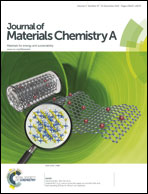Silica direct evaporation: a size-controlled approach to SiC/carbon nanosheet composites as Pt catalyst supports for superior methanol electrooxidation†
Abstract
Carbides have been regarded as a kind of promising support to improve the utilization of Pt as the anode catalyst in fuel cells owing to their Pt-like properties. Unlike other carbides, relevant studies about SiC are scarce because the effective synthesis is challenging from a small size of SiC and high performance in electrochemistry. Herein, we develop a novel and facile vapor deposition strategy to synthesize nanocomposites composed of 17 nm SiC nanoparticles uniformly dispersed on graphitic carbon nanosheets (denoted as SiC/GC) derived from silica ceramic chips and coconut shell–Fe3+ (CS–Fe3+). In the synthesis, the CS–Fe3+ was first transformed to GC, and then the silica vapor from ceramic chips could deposit on GC, meanwhile, the reduction of silica to SiC would occur and the SiC/GC composite was obtained. Because of the synergistic effect and unique structures, the as-prepared Pt–SiC/GC with a low loading of 10 wt% Pt exhibits a superior activity of 1585.3 A g−1 Pt towards methanol electrooxidation, which is about 6.2 and 5.0 times that of the commercial 20 wt% Pt/C(JM) and 30 wt% PtRu/C(JM) catalysts, respectively, combined with larger ECSA, better stability and superior CO stripping.


 Please wait while we load your content...
Please wait while we load your content...